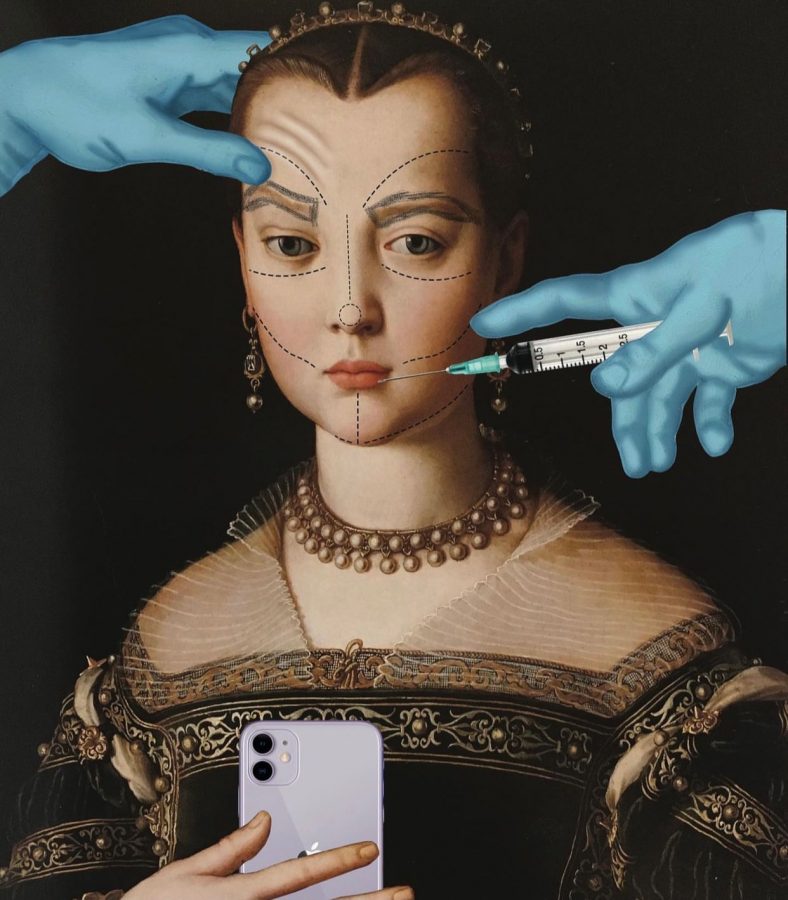My View
 |
| @crudeoil2.0 on Instagram |
Nowadays, researchers consider social media the highest potential risk for body dissatisfaction amongst women and men (Rodgers and Melioli, 2016). Many studies concern this matter and social media use, yet, the results vary. Some studies argue that body dissatisfaction has a connection to social media use (Fardouly et al.,2017; Scully et al.,2020), whereas some studies disagree and find a favourable link (Cohen et al.,2019), and other researchers do not see a relation between the two factors (Ferguson et al.,2014). Social media platforms include a lot of content that is not sometimes realistic. An example can be fitness content creators that often show how to exercise appropriately for beginners. Most fitness influencers post photos while they are angling instead of the realistic image of their bodies in a normal state.
The primary issue is photoshop which influencers often use on social media platforms. Therefore, they create an unrealistic idea for the followers that frequently compare themselves with their ''idols''. In this case, there is a link to a Beauty Myth theory by Naomi Wolf. The theory proposes that the beauty myth conveys an ideological message that women should constantly treat their bodies as an assignment that ought to be enhanced (Wolf, 1990). Even though I agree with this theory, I believe that it should not include just women; the situation relates to everyone who follows these people and believes in the perfect body.
Nevertheless, I think that this issue is decreasing as many people spread awareness about the matter, such as through some brand advertising. For example, one year ago, Dove, the beauty brand, published an advertisement about social media pressure on girls. The advertisement's main character is a young girl wearing makeup. The girl is scrolling through social media while receiving likes on her photo, represented as photoshopped. In addition, there is a close up of a phone screen while the character tries all the different filters and features. After trying out the filters, suddenly, she removes all of her makeup and looks naturally. The advert points out how pressured people (especially girls in the ad) are due to the photoshop on social media and all the available filters. Therefore, people create an image of the ''ideal'' face, body, or other features.
Link for Dove advertisement : https://www.youtube.com/watch?v=z2T-Rh838GA
Moreover, comparisons with famous people on social media, such as models, sports stars, and actresses who symbolise beauty ideals, are connected to body dissatisfaction in adolescence (Edcoms and Credos, 2016; Burnette et al., 2017). Additionally, sharing photos of bodies and faces on social networks make young adults more likely to compare themselves and critique themselves (Chua and Chang, 2016; Bell, 2019). Research has also shown that girls are more likely to compare themselves and look carefully at their followers' likes, comments, and interactions (Kenny et al., 2017).
To conclude, I believe that this matter is getting better; however, society should spread the word even more, maybe in education, so young children know about the problems caused by social media usage. It is essential to use the natural part of our lives online and think about the picture we see before comparing ourselves with the ''beauty ideal''.
References:
Bell, M. J., Rodgers, R. F., & Paxton, S. J. (2017). Towards successful evidence-based universal eating disorders prevention: The importance of zooming out. Eating Behaviors, 25, 89–92. https://doi.org/10.1016/j.eatbeh.2016.10.012
Burnette, C. B., Kwitowski, M. A., & Mazzeo, S. E. (2017). “I don’t need people to tell me I’m pretty on social media:” A qualitative study of social media and body image in early adolescent girls. Body Image, 23, 114–125. https://doi.org/10.1016/j.bodyim.2017.09.001
Cohen, R., Newton-John, T., & Slater, A. (2017b). The relationship between Facebook and Instagram appearance-focused activities and body image concerns in young women. Body Image, 23, 183–187. https://doi.org/10.1016/j.bodyim.2017.10.002
Dove US. (2021, April 20). Dove | Reverse Selfie | Have #TheSelfieTalk [Video]. YouTube. https://www.youtube.com/watch?v=z2T-Rh838GA
Fardouly, J., & Vartanian, L. R. (2016). Social Media and Body Image Concerns: Current Research and Future Directions. Current Opinion in Psychology, 9, 1–5. https://doi.org/10.1016/j.copsyc.2015.09.005
Ferguson, C. J., Muñoz, M. E., Garza, A., & Galindo, M. (2013). Concurrent and Prospective Analyses of Peer, Television and Social Media Influences on Body Dissatisfaction, Eating Disorder Symptoms and Life Satisfaction in Adolescent Girls. Journal of Youth and Adolescence, 43(1), 1–14. https://doi.org/10.1007/s10964-012-9898-9
Chua, T. H. H., & Chang, L. (2016). Follow me and like my beautiful selfies: Singapore teenage girls’ engagement in self-presentation and peer comparison on social media. Computers in Human Behavior, 55, 190–197. https://doi.org/10.1016/j.chb.2015.09.011
Kenny, U., O’Malley-Keighran, M. P., Molcho, M., & Kelly, C. (2016). Peer Influences on Adolescent Body Image: Friends or Foes? Journal of Adolescent Research, 32(6), 768–799. https://doi.org/10.1177/0743558416665478
Mahon, C., & Hevey, D. (2021). Processing Body Image on Social Media: Gender Differences in Adolescent Boys’ and Girls’ Agency and Active Coping. Frontiers in Psychology, 12. https://doi.org/10.3389/fpsyg.2021.626763
Rodgers, R. F., & Melioli, T. (2015). The Relationship Between Body Image Concerns, Eating Disorders and Internet Use, Part I: A Review of Empirical Support. Adolescent Research Review, 1(2), 95–119. https://doi.org/10.1007/s40894-015-0016-6
Scully, M., Swords, L., & Nixon, E. (2020). Social comparisons on social media: online appearance-related activity and body dissatisfaction in adolescent girls. Irish Journal of Psychological Medicine, 1–12. https://doi.org/10.1017/ipm.2020.93
Lia, I really enjoyed exploring your blog. I appreciate the aesthetics of it as well as the contents. I like how in this particular post, you included both the many negatives and the beginnings of positives in our society. Body image is such an important topic today and needs more representation for both men and women of all ages. I specifically liked how you bring up the Dove campaign of the girl wearing using filters. I also remember a Dove campaign called "Be Real" showing women of all ethnicities and body sizes! I believe that more and more companies should follow after Dove and other body positive companies.
ReplyDelete